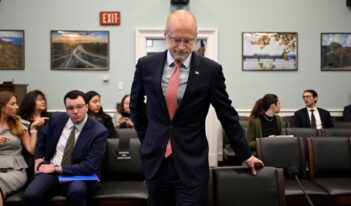
The Supreme Court reinforces and expands its 2024 ruling in Loper Bright.
The U.S. Supreme Court’s opinion in McLaughlin Chiropractic Associates v. McKesson Corp. is ostensibly about the Telephone Consumer Protection Act (TCPA), the 1990s-era law that—also ostensibly—makes robocalls and junk faxes illegal. But the opinion’s real importance is to reinforce last year’s decision in Loper Bright Enterprises v. Raimondo. That decision formally overruled Chevron v. Natural Resources Defense Council, and with it the era of default deference to reasonable agency interpretations of ambiguous statutes.
McLaughlin expands Loper Bright’s holding: Courts—not agencies—bear primary responsibility for interpreting statutes, unless the U.S. Congress expressly provides otherwise. Justice Brett Kavanaugh explained that “fundamental principles of administrative law establish the proper default rule: In an enforcement proceeding, a district court must independently determine for itself whether the agency’s interpretation of a statute is correct.”
Under the TCPA, it is illegal to send fax advertisements unless the recipient opts in. At the risk of being too clever about it, the rule in McLaughlin can be cast in similar terms: Agencies do not get the benefit of judicial deference unless Congress expressly opts them in to it.
For years, TCPA class actions followed a familiar pattern. Courts often brushed aside even strong statutory arguments, pointing to the Federal Communications Commission (FCC) and declaring the issue settled. The Hobbs Act gives courts of appeals “exclusive jurisdiction” to review FCC orders, and if no one challenged an interpretation within 60 days, it was treated as binding—even in later private litigation.
That approach, while long contentious, made a certain amount of sense in the Chevron era. But the Court’s 2024 decision in Loper Bright formally ended that era. Now, one Supreme Court term later, McLaughlin shows how the post-Chevron world works in practice. Following the logic of Loper Bright, the Court held that district courts are not required to adopt agency interpretations in TCPA enforcement cases. Agencies may interpret statutes, but absent a clear congressional mandate, courts are not obliged to accept those interpretations.
The facts in McLaughlin are textbook TCPA: McKesson, a health care company, sent unsolicited fax advertisements to medical offices in 2009 and 2010. Some were received on traditional fax machines, others via online fax platforms that route messages to email. McLaughlin, who received some of the faxes, filed a putative class action covering both.
Years into the case—after class certification—the FCC issued its order in In re Amerifactors Financial Group interpreting “telephone facsimile machine” to exclude online fax services. That wiped out most of the proposed class and damages. Relying on precedent from the U.S. Court of Appeals for the Ninth Circuit, the district court accepted the FCC’s view under the Hobbs Act and granted partial summary judgment for McKesson. The Ninth Circuit affirmed.
The Supreme Court reversed. The Hobbs Act, it held, does not bar district courts in enforcement proceedings from reaching their own conclusions about what the law means.
Not all of the justices agreed. In dissent, Justice Elena Kagan—joined by Justices Sonia Sotomayor and Ketanji Brown Jackson—argued that the Hobbs Act’s structure precludes collateral challenges to agency orders. For the dissent, this case was less about deference and more about finality: Once an order becomes final, courts must treat it as binding.
The majority rejected that view, distinguishing between the validity of the order and a court’s responsibility to interpret the statute independently. Writing for a six-justice majority, Justice Kavanaugh emphasized that although the Hobbs Act governs pre-enforcement review, it does not override the default rule of the Administrative Procedure Act that courts interpret statutes independently unless Congress says otherwise. Agency interpretations can be persuasive but not controlling. The fact that an FCC order went unchallenged in the Hobbs Act window may bar facial review of the order—but not consideration of the underlying statutory question in an enforcement action.
In some ways, the holding is straightforward. Courts—not agencies—say what the law is. That was true before Chevron, technically remained true during it, and is front and center after Loper Bright.
What is notable is that the Court had to say it again—this time about the Hobbs Act. Over the years, federal courts of appeals—especially the Ninth Circuit—had treated agency interpretations as immune from scrutiny, even when parties never had a chance to challenge them.
That makes McLaughlin an important post-Loper Bright correction. The Court rejected the idea that procedural exclusivity turns agency views into shadow law. And it began dismantling Chevron-era habits of reflexive deference that had crept into broader doctrines of jurisdiction and review.
At the surface level, McLaughlin is significant for TCPA litigation. Courts are no longer required to treat FCC interpretations as binding in cases involving autodialers, prerecorded calls, consent, or faxes. That shift will affect class certification, summary judgment, and litigation strategy—especially in circuits that had treated Hobbs Act orders as conclusive.
But the deeper significance is administrative. McLaughlin is another step in recentering courts as the primary interpreters of law, including in fast-evolving domains like telecom. As the FCC stretched the TCPA to fit new technologies, it often issued interpretations that strained the statute’s text. That dynamic, tolerated under Chevron, now faces tighter scrutiny. McLaughlin affirms that agencies do not have the last word on how far the law can stretch.
It also reinforces a core principle: An agency’s interpretation may bind itself, but not the courts. And in areas where multiple agencies touch overlapping statutory terms—as often happens in modern regulatory frameworks—judicial independence is essential. Agency-specific readings cannot dictate the meaning of law across the board.
Expect renewed interest in TCPA litigation. Defendants will challenge longstanding FCC interpretations—such as what qualifies as an autodialer or what counts as “prior express consent.” Plaintiffs will invoke Skidmore v. Swift deference, arguing that the FCC’s expertise makes its interpretations of statutes compelling to, if not controlling upon, judicial interpretations. Courts will weigh how persuasive the agency reasoning really is—especially when it is outdated or issued without robust process.
McLaughlin may also prompt a broader look at the Hobbs Act. Originally intended to centralize review of rate and licensing orders, it was never meant to insulate general statutory interpretations from judicial review in enforcement proceedings. The decision is a reminder: Congress sets the rules, but courts interpret them.
In the end, McLaughlin v. McKesson is not a revolution. But it is a course correction. And in TCPA litigation—where silence is rare, and “quiet” calls are often the issue—that is saying something.
This essay is part of a series, titled “The Supreme Court’s 2024-2025 Regulatory Term.”




